Glossary
This guide was last updated in 2013 and some of the rules of copyright may have been revised and added to in the intervening years, particularly in regards to digital use.
The right of a photographer to have his name listed in a publication - preferably beside the photograph - as the person who took it. Same as credit, attribution and paternity right. If a photograph, whether digital or analogue is well labelled with name, contact details and a copyright symbol, it shouldn’t be necessary to ask for an acknowledgment but in order to strengthen a claim, it’s a good idea to get the request in writing. Most publishers are pretty good about it. Some newspapers are not when it comes to individual photographers and tend to blow a bit hot and cold. The same applies to designers who don’t like spoiling their layouts with spidery little credits. Magazines and newspapers are not obliged to supply a credit although many do because on the whole, it’s a good idea to keep suppliers happy. Occasionally the acknowledgment can become absurd. When Robert Rauschenberg died in 2008, his obituary in The Guardian included a reproduction of a painting with a credit line listing five different companies.
Advertising is any sort of promotion of a product or a service. Photographs used in advertising or features must have either a model release or a property release because the assumption is the person in the photograph endorses the product or service. Since advertising is usually a dream world and nothing more than idealistic make-believe, using stock photographs with no release is treading on dangerous territory. The idyllic, thatched country cottage may have had insurance cover refused by the company it appears to be endorsing. It may be painted or even owned by a director of a rival company. The pretty girl on the beach may be a professional model under contract to an agency; the sportsman will almost certainly be under contract to somebody else and even if there are no contracts involved, no advertiser has the right to suggest that anyone endorses a product without first making sure that they do. Advertising includes any advertisement in magazines, newspapers, TV, the web, brochures, flyers, posters, packaging, the back of a bus - absolutely anything which is promoting a product and that includes those strange, artificial items in magazines and newspapers which come under the heading of ‘Advertorial’. It’s advertising because it was paid for by a company who wish to suggest to readers that it was all the idea of the magazine and was nothing to do with the advertiser.
see Editorial
'Assignment' is a verb or a noun and means different things. The verb 'to assign' means the legal transfer of copyright from one person to another - photographer to publisher, publisher to a collector of photographs, photographer to a picture library when he’s had enough and wants to retire, inheritor of a collection via a will, auction house along with prints and negatives, institution or museum in lieu of inheritance tax. Whatever, it must be in writing and shouldn’t be done unless absolutely necessary.
The noun 'An Assignment' is what a photographer gets when a client asks him to do a job of work but it does not mean the client also gets an assignment of copyright unless the terms of the assignment are written and signed and provide specifically for an assignment of copyright.
Where photography is concerned this means the person who took the picture although it could mean the stylist or art director who set it up if the photographer did nothing other than press the shutter. In that case, the stylist or art director could claim copyright in the result. There can be more than one author. If two people together set something up and photograph it, they will have joint copyright as authors of the photograph and whoever lives longest sets the timetable for when copyright expires - seventy years after the end of the year in which he dies.
Never photograph bank notes or coins or stamps or maps and never reproduce them without obtaining clearance from the relevant government department. Not only are they protected by copyright, they all have their own rules about protection from fraud and forgery. Beware of sticking a stamp on an envelope with the Queen upside down because that is treason, as it is to give her spectacles and a moustache on a bank note. Ordnance Survey maps have stringent rules. A yearly licence to put printable maps on a web site can cost thousands of pounds for the digital data although if you buy a paper licence and scan maps which have been purchased and put them on the web site, the cost comes clattering down to an amount which wouldn’t frighten anybody - but you still need the paper licence. The London Underground map requires a licence before it can be reproduced and copyright will never expire because every new line means a new map and a new copyright. The Royal Arms are protected too so photographers should beware of casually taking pictures of buildings or transport with such things emblazoned upon them and don’t keep your ordinary EU passport in a fancy leather holder with the Royal Coat of Arms on it because it’s illegal! The Bank of England, the Lord Chamberlain, the Treasury, the Stationery Office and Royal Mail will advise if permission for reproduction of pictures of their protected products and designs are required - if you can get through their voice mail.
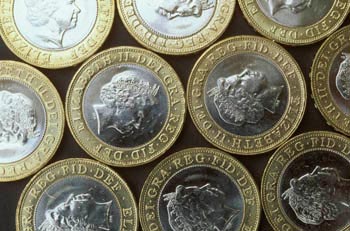
Perhaps coins like this might be overlooked, but publishing a picture of paper money would not be. The Bank of England are very severe. Collections/Ashley Cooper
An agreement to honour the rights of authors who are nationals of countries which have signed the Convention. This is practically everywhere now but certainly wasn’t in 1886. Nowadays it’s all administered by WIPO - World Intellectual Property Organisation and the rules and signatories change as often as the EU add bits to copyright. The Berne Three-Step Test is a clause included in several international treaties on copyright which imposes constraints on the possible limitations and exceptions to exclusive rights under national copyright laws. Article 13 of The Trade Related Aspects of Intellectual Property agreement, known as TRIPS reads:
Members shall confine limitations and exceptions to exclusive rights to certain special cases which do not conflict with a normal exploitation of the work and do not unreasonably prejudice the legitimate interests of the rights holder.
Most references print the three steps in bold for emphasis. What does it mean? The legal reasoning used to suggest how this wording should be interpreted is described as ‘arcane’ , a word which the OED defines as ‘mysterious, secret’. However the three-step test should prove its worth if any nations decide to reduce the scope of copyright law. Efforts in the US to make Orphan Works readily available are a case in point.
See Orphan Works
Of all subjects, the photography of children is the most difficult. Specialist photographers have given up lucrative careers in the face of the bureaucracy they face if they wish to continue to photograph children. In the days of analogue photography which wasn't long ago, laboratories and High Street processors were paranoid about what they saw in the films they processed and called the police to deal with mothers who had photographed their children naked in a paddling pool or playing with bubbles in a bath. Professional photographers shooting for stock on a beach have been arrested because there were children on the beach. Reputable photographers have been knocked up at dawn by police and their entire archive confiscated. True, there are people who take pictures of children for the wrong reasons, always did and always will. Digital photography has just made it easier and sadly, copyright in the photographs these people have taken still remains with the photographer although he might be disinclined to acknowledge it.
Avoid photographing children anywhere near a school; without asking their parents’ permission; at a playground; on a beach; naked; in hospital; at school plays and events; at sporting venues. Certainly avoid anything provocative however precocious the child may be and girls can be outrageously provocative from a very early age and many thirteen year olds are indistinguishable from young adults. Bear in mind that a child is a child until sixteen and in a few cases, eighteen. Clearly the problem is defining what is a provocative photograph and what isn’t. A small-minded, red-necked police sergeant may consider eye contact, too much leg, thumb-sucking or sprawling in a chair provocative whilst most people will look upon these as normal behavior. Sadly, he may well accomplish the classic dawn raid, thus destroying the credibility of the photographer since the media believe there is no smoke without fire. No amount of oil poured on these troubled waters by those who know better will achieve anything - it will simply ignite the fire - as oil usually does.

A toddler (Sal!) in Regents Park. This was in 1937 when it wasn’t a problem. Despite the fact that this particular toddler is in a state of undress, she was looked upon with approval by a very old Sigmund Freud who was also in the park. These days publication could lead to ructions.
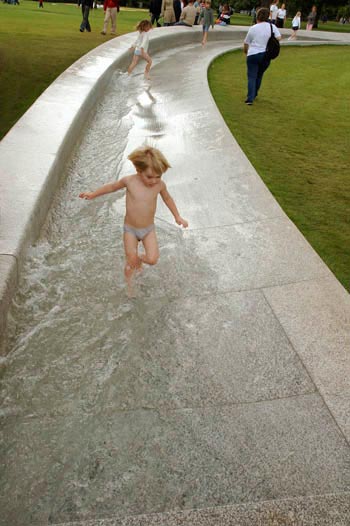
Diana Fountain, Kensington Gardens. Half naked children are marginally more acceptable than naked children, but images such as this should be published with caution. Collections/Sandra Lousada
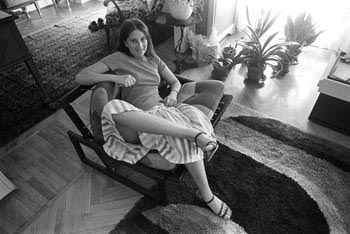
Camilla. She was about 14, going on 24. Beware! Collections/Brian Shuel
If a collage is made from bits cut out of magazines, photocopies, postcards, images downloaded from the web, there is no copyright infringement - until the collage is published or made available to the public when multiple copyrights may be breached. The actual collage may acquire copyright in itself simply by being a creative work of art but will nevertheless include a lot of problems which may be insurmountable.
A non profit-making organisation which, for an overall fee, licenses certain uses of copyright protected photographs - such as photocopying. This is taken up by schools, colleges and universities as well as large companies. Photographers registering with DACS, the Design and Artists Copyright Society may reap a surprisingly substantial reward. It’s not difficult to register and it’s worth it.
When a photographer is asked to take pictures for a client, he is commissioned. He is not employed. The commissioner cannot claim copyright in the pictures but does have certain rights as to what can be done with them. A commissioner who requires copyright should be prepared to pay a small premium for the right to acquire it but should not put unreasonable pressure on the photographer. A photographer who prefers to retain copyright has the right to do so but should make this clear from the outset.
see Crown Copyright
Unwritten law. Common Law has developed over time and is based upon precedent and decisions made by the Courts rather than Parliamentary legislation. Most Common Law was written out of the 1911 Act with some written in again as part of the new Act but other items continue to creep back in every time an appropriate case goes to Court. Common Law is often Common Sense. When a judge makes a decision in Court, this may set a precedent for future cases. This is particularly important these days as judgments appear concerning the rights of celebrities to freedom from harassment. The judgments are allowing privacy laws to creep in through the back door without the need for HM Government to do anything about it which is not necessarily a good thing because there may be side issues about which there has been no opportunity for debate. Lots of bizarre laws still exist which are common law and have never been changed. Never eat mince pies on Christmas Day or get close to the monarch without wearing socks. It's Common Law.
There are publications and companies which promote photographic competitions. Treat these with suspicion and read the small print on the entry form. Somewhere it could include an assignment of copyright - certainly for the winners but in all probability for everything entered. Do not enter the competition and register your objection instead. If it’s a big competition, try pointing it out to the photographic media. The story will spread and will embarrass the company organising the event.
Copying a print photographically, printing it in a publication, storing it on a computer, photocopying it, making a three dimensional sculpture from a two dimensional photograph or creating a painting which slavishly copies the photograph or a substantial part of it. Thousands of paintings are created by painters using photographs. Some may believe that because they are making something new, there will be no problem but many are well aware of what they are doing. It is not enough to change the colours, leave out people, flip the image from left to right and add a few clouds; many photographers have total recall when it comes to their images and will know immediately.
See Infringement
An independent body which settles licensing disputes arising between parties who are unable to agree between themselves. They are contacted through the UK Intellectual Property Office.
In 1786, a new Treasury department was formed, His Majesty’s Stationery Office (HMSO) which in 1882 became the official publisher to both Houses of Parliament and took over control of Crown Copyright which, for many years, was any work created by a government department or a servant of the Crown. In recent years HMSO has been privatised and alternative publishers are under contract to publish some items although The Stationery Office Ltd continue to do a lot of it and some trading functions have been taken on by the Office of Public Sector Information (OPSI), part of the National Archives, which also took on the convoluted rules by which Crown Copyright is governed.
There is a definition which says ‘work made by Her Majesty or by an officer or servant of the Crown in the course of his duties’ which conjours up a picture of The Queen wielding her Leica out in the field. An ‘officer or servant of the Crown’ can be a photographer who has been commissioned to work with the services or for the Government and such photographers do not get to keep their copyright. The Central Office of Information (COI) often commission photographers to work on their behalf. Regardless of what the photographer has to do, the photographs are Crown Copyright. A photographer who covers Trooping the Colour for himself is not affected but if he is commissioned by the COI, the photographs will be Crown Copyright. If on the other hand, he is asked to do it by The Queen for her own private use, she is the commissioner, copyright remains with the photographer but he can’t do anything with the pictures unless The Queen agrees - and neither can she unless he does.
The King James Bible, otherwise known as the Authorised Version appeared in 1611 and was considered so important that rights were ‘vested in the crown’ in perpetuity’. The rights fall under ‘The Royal Prerogative’ and as such are perpetual. These rights are different from Crown Copyright which will eventually expire; perpetual rights are for ever. Theoretically ‘The Royal Prerogative’ means The Queen can appoint the Prime Minister and various other officials, can approve laws, grant pardons and declare war. The reality is somewhat different! By prerogative, the monarch can do no wrong and is therefore immune from prosecution.
Crown Copyright has a different term of protection from everything else. Where photographs are concerned, it is one hundred and twenty five years from the end of the year in which the photograph is taken unless it is ‘published commercially’ during the first seventy five years in which case it gets fifty years from the end of the year in which it is taken. Thus, if a crown copyright photograph is taken today and published tomorrow, it will be out of copyright fifty years after the end of this year but if it’s taken today and not published for seventy five years, it will go full term. ‘Published Commercially’ means pretty much what it says and also means making it available by means of an electronic retrieval system.
This is a new right, described in one book as ‘a creature of EU law’ which appeared on 1 January 1998. It’s like copyright and is designed to protect a database which has been created either electronically or manually. Protection is for fifteen years from the end of the year in which the database is completed and it’s in addition to copyright in any individual images. It could cover compilations of images by photographers which have been put together in a systematic and methodical manner. That leaves a huge question mark. Every picture library and photographer who creates a database in order to sort out photographs should be covered but who knows how? It’s all a bit new and untried. The right is only available to the maker of the database and that person has to be part of the EU but like copyright, there can be more than one person in which case there is a joint Database Right. Apart from anything else, there is the difficulty that protection is fifteen years from completion of the database and what database is ever complete? The maker of the database has the right to prevent extraction and/or re-utilisation of the whole or of a substantial part of the database but extraction and re-utilisation need careful definition. Anyone getting in a mess with database rights would be well advised to head for the nearest reliable lawyer.
Not really a copyright issue but delivery notes do have terms and conditions attached to them and these include a chunk which explains to a client what they can and cannot do. Clients are expected t read them and the fact that they don’t do this is their problem when something goes wrong because the best delivery notes and terms and conditions are created with considerable care in order to protect the owner of the property. Whilst delivery notes should always be attached to digital files sent by e-mail, they were particularly important when analogue images were being sent out and on the rare occasions when this still happens they are even more vital since few people have any idea how to deal with analogue images these days. Nothing analogue should ever be sent without a delivery note which should include a detailed list of what has been supplied, a note of when images should be returned, how much will be charged if they are returned late and a clearly written amount payable should the client lose them. Clients who lose photographs often attempt to prove delivery notes constitute a penalty but nobody has yet succeeded.
The history of delivery notes and terms and conditions of business has changed since the advent of digital supply of images because the requirements are different. Loss is no longer a problem and digital delivery notes are more concerned with what the client can do with what has been made available. Every supply of images should be accompanied by some form of delivery note which makes it absolutely clear what a client can and cannot do.
There comes a time when everything analogue which is worth scanning has been scanned. What to do with the transparencies, the dupes, the negatives and the old prints? Storage of thousands of transparencies may not be an option, prints take up a lot of space and deteriorate and if the material is unedited, it will include huge amounts of edited rubbish which may well end up in a black plastic bin-bag on the way to the dump. This is not a good idea. Before disposing of anything, make sure it is not the copyright property of someone else. Where dupes are concerned, whoever paid for the dupe owns the physical film and mount so library dupes supplied by contributing photographers should be returned. Having ascertained that all is well, think very seriously about whether you may regret disposal. If what is in the bin-bag really is the dross, then find a shredding company, pay to have it all disposed of correctly and insist upon a document stating this has occurred. An office shredder will not take kindly to shredding thousands of mounted transparencies. Google ‘Shredding Paper’ and contact the best site you can find, explaining what it is you need to shred. There are companies who will shred transparencies regardless of how they are mounted. The same applies to prints although the office shredder may be able to cope with these but beware of shredding anything for which there is no negative. Never shred black and white negatives. Keep them. As for anything more than twenty or thirty years old, beware of disposing of history. With the edited material which is still on file, edit it again and keep the best. Who knows; the Internet may one day be invaded by voracious bugs, no oil, no electricity, analogue may come back and we may find ourselves once again sending transparencies and prints by post and courier.
As for the return of transparencies and prints from picture library to contributing photographers, it is expensive and takes months but it must be done. The material is the property of the photographer. If a contributing photographer asks a library to dispose of material, get it in writing first.
Difficult to define. I am indebted to Tom Morgan from the National Portrait Gallery for his definition which seems eminently reasonable when applied to books.
...the term ‘edition’ will be understood to denote a single set of words, pictures and page layouts, usually a single book, identified by name (title) and defined at the point in time of its first publication in print form. The term ‘all editions’ will therefore be understood to include re-publication of the same set of words, pictures and page layouts in print form, revised from the first published edition by up to 10%, translated into foreign languages, bound as a paperback or hardback or multiple volumes bound into one, or one volume bound into multiples.
It should be added that if the ISBN number changes, it’s a different publication altogether. The ISBN is a product number used for listing books only and is always on the first page along with all the copyright information and usually on the back above the bar code and the price. An ISBN identifies the publisher and the book. Magazines use ISSN instead but this is an arbitrary numbering system which identifies nobody. Make sure all details are clear before agreeing anything and word invoices or requests for usage with great care to avoid confusion later but never forget that the goal posts are liable to change at any time.
Editorial use means books, magazines and newspapers - anything which is not promoting a product or a service There is an assumption that if a photograph is used editorially, no model or property releases are necessary and in many situations this is true - but not for everything.. On the whole, in the UK, photographs of people and places are not a problem and a release is rarely requested. Travel pages are full of beaches, stately homes, mountain walks and cityscapes and they may include people - who may protest if they feel their privacy has been invaded. Likewise, house owners may object if they suspect trespass or simply resent their property appearing in a magazine. When a photograph is used editorially, no product is being endorsed and sustainable objections are rare. The problems arise when a publication runs a contentious article. Child abuse, drug abuse, illegal immigrants, shady dealings in the city or within the police force - all regular magazine fodder often illustrated with photographs captioned ‘posed by models’. The difficulty is that under these circumstances, there must be a physical model release and often there is not. Photographers and picture libraries generally supply images in good faith. It is not unknown for a publisher to ignore the supplied caption and thus, a photograph of a child bruised playing football becomes a child bruised by a violent father; a young and pregnant woman becomes an example of lack of morals; a father and son walking hand in hand in the park becomes a grooming paedophile making off with his prey; half a dozen girls in a bar with one bottle of wine between them becomes binge drinking. Picture libraries and photographers need to police the use of everything supplied for use editorially and publishers need to think twice about their paperwork when it comes to publishing anything which requires a caption reading ‘posed by models’.
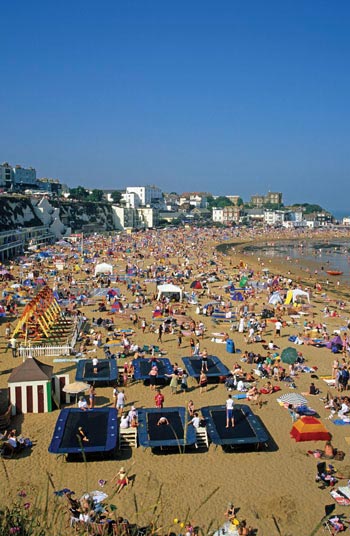
Nobody recognisable so this would be acceptable for advertising, but perhaps not a great advert for Broadstairs! Collections/Brian Gibbs
There is disagreement as to what constitutes an ‘employed photographer’ but in fact a good yardstick for defining him is if his employer pays his PAYE and National Insurance in which case, he is employed and his employer owns copyright in everything done in the course of employment unless the photographer can persuade him otherwise. Occasionally a client will claim that a lengthy commission constitutes employment and it pays to read the small print in any contract to ensure that copyright isn’t being inadvertently assigned.
One of the keenest lobbyists when the 1988 Copyright Act was in preparation was a photographer who had some years before been commissioned by a magazine to photograph a stout, Greek singer called Demis Roussos who had lost a bit of weight and was modelling a smart smoking jacket. He dutifully handed over the photographs since they were commissioned pre-1988. Shortly after this, Demis Roussos found himself on an airplane which was hi-jacked. The commissioners jumped on the bandwagon and distributed the photographs worldwide charging substantial reproduction fees. The photographer got nothing but he did become a great lobbyist.
Everything which was still in copyright on 1 January 1996 when the new EU recommended provisions came into effect became seventy years pma. Photographs had twenty years tacked on to the fifty years pma which was laid down in the 1988 Act. This period is called extended copyright. Ownership is naturally complicated. The photographer may have granted licences or assigned copyright. If that was the case, the owner of the extended copyright is whoever owned it before 1 January 1996. If the assignment or licence are for a lesser period, when the time runs out, copyright reverts to the photographer for seventy years pma
see Revived Copyright
This is what a picture user is allowed to do without getting permission from the copyright holder or having to pay. It includes:
- Research and private study. This doesn’t give the user the right to copy everything but it does allow for limited copying from publications.
- Criticism and review. Reproduction of a photograph is allowed when a book is reviewed. Just publishing an image from a book without comment in order to fill up an otherwise dull page is not permitted. There has to be some sort of review or promotional caption advertising the book with full details. The photograph should be credited. If the publisher makes images available from a book for review purposes, usually no fee is payable. If it’s possible to scan from the page of a book for a review of the same book, that is also permitted. If the reviewer has to go to the photographer for images, the reviewer should expect to pay a fee for the service provided although this might be negotiable. The reviewer should ensure the copyright holder has agreed to the use of the image before publishing anything, particularly if the image has arrived from a source other than the publisher. It is all too easy for an author to supply pictures for which he does not own copyright in the mistaken belief that he has the right to do so.
- Reporting current events. The 1988 Act reckoned that reporting current events was Fair Dealing but it was one of the things which photographers and their trade associations managed to change. Photographers are specifically excepted from this on the grounds that it would otherwise spell financial ruin.
- Copying for instruction but not by any reprographic process - which means you can copy a photograph onto a blackboard with chalk but not photocopy it. This has resulted in licensing schemes which allow copying for instruction for an annual fee which is collected and distributed amongst any copyright holder who has gone to the trouble of registering with the organiser of a licensing scheme. If a copy is made for some other reason than for instruction the situation would not be the same. A black and white photograph, copied in paint as a mural in a public place will be an infringement of the photographer’s copyright. No matter that it may look spectacular; ask permission first.
see Collecting Society
- Examination Papers. Those setting examination papers can copy although if it is necessary to get photographs from an original source and not from a book, the examination board should expect to pay for the service.
- Conservation. Libraries and archives can copy for conservation purposes although what they can copy is at present under discussion. The general idea is that they should be allowed to copy digitally in order to preserve but not for any other reason.
- Advertising a work for sale Photographs of artistic works can be used when advertising a work for sale. In other words, if it appears on a poster or in a catalogue - which could well be on sale long after the sale is over and become a collectors item in itself.
- Works on Public Display. See Privacy
- Incidental inclusion See Moral Rights
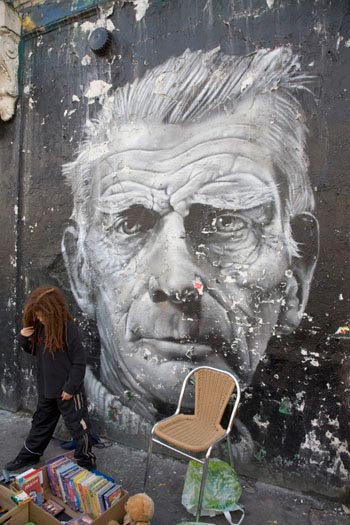
Mural of Jane Bown’s portrait of Samuel Beckett on a wall in Notting Hill. Publication would require permissions from Jane Bown, the painter of the mural (who must also have asked for permission) and the photographer. Collections/Michael Jenner
This is the right of a photographer not to have a work falsely attributed to him. It may seem a slightly odd right but it matters if a photographer is credited with a really bad photograph which he didn’t take and it matters even more if it’s a photograph of a riot of some sort where he could later be targeted by those who were involved who may have been arrested because of what the photograph indicated. This right is available to everyone including those who are employed. It is personal and does not go hand in hand with copyright, thus protecting press photographers employed by newspapers.
If a chunk of a copyright work appears in a photograph which is about something completely different, it shouldn’t be a copyright infringement although it all depends on what the work is and how much of it shows. Is this a picture of a person who happens to be standing beside a copyright protected object which is entirely incidental or is this a picture of a copyright protected object with an entirely incidental man standing beside it? It used to work like that but it doesn’t any more in these litigious days. Beware of taking a photograph of anything which has copyright protection, unless it’s an incidental sculpture in a public place and even these are suspect nowadays. What constitutes ‘incidental’ is debatable. If it looks as if the copyright work - albeit out of focus - is an integral part of the final picture, it may not be deemed to be incidental. If in doubt, leave well alone because getting it wrong could be costly.
Incidental inclusion also covers things which appear in films and on TV. A room setting in a film may include books, records or CDs, paintings, photographs and even postcards pinned to a wall. All this stuff has to be cleared before it can be filmed. A poster on the side of a bus may have to be specially commissioned in order to avoid problems if it appears in a film. A pop poster on the wall of a teenager’s room may need clearance from the publisher, the artist and the photographer. If the filming is for a news story, the situation is different but if not, there may be a lot of permissions required. Fortunately there are specialist companies who will deal with it all - at a price. Costume dramas are the easy way out. No posters, books or CDs - although even then, some sharp-eyed designer may recognise the wallpaper.
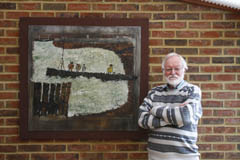
Brian Shuel with a painting. The painting is not incidental inclusion and clearance must be obtained for publication.

A portrait of Brian Shuel. The painting is out of focus but is still not entirely incidental.
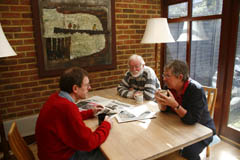
The Shuel Family. The painting is incidental but with some particularly recognizable painters it might still be a problem.
When a copyright image is published without permission, this is an infringement unless copying is expressly permitted by law. It doesn’t matter where the photograph came from, if it appears without permission, it’s an infringement. The rule of law says ‘Ignorance of the law is no excuse for failure to obey’. It’s not enough to say you didn’t know. If you infringe, you have no alternative other than to pay up. Payment may only be a reproduction fee but if the copyright holder is determined, it could be more and if whoever has caused the infringement decides to be difficult, takes it to court and loses it could become seriously costly and lead to the destruction of the infringing work - which could be thousands of books! Painters may infringe by using other paintings to create new works. Occasionally these are highly respected artists, Turner Prize nominees, their work much sought after. Occasionally the original artist fights back. Usually they settle out of court.
See Copying
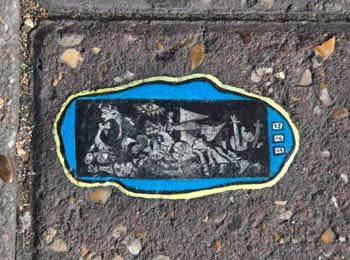
Infringements come in bizarre forms. In North London, a street artist called Ben Wilson paints tiny pictures on spots of chewing gum. They are usually about the size of a 50p piece and he will do one for anyone who asks. They commemorate anniversaries and birthdays and the pavement is covered with them. Periodically he cleans them and touches them up but they are not permanent; they wear away and the council are inclined to relay the pavement occasionally. They are extremely pretty, delicate and enormous fun. His pièce de résistance is ‘Guernica’. The original is still very much in copyright and the estate of Picasso is very possessive. It’s a recognizable copy and it’s clearly a copyright infringement. Publishing a photograph of it is not only an infringement of ‘Guernica’ but also of Ben’s tiny copy. The chances of the Picasso estate protesting are pretty slim. The media would have a field day with a copyright infringement which is 5cm long, is painted on chewing gum and depicts a painting which is 12ft by
In other words, copyright. Abbreviated to IP, this allows everyone to own the things which they have created, to control what happens to those things and to benefit financially from them. In general, ideas and concepts are difficult to protect but from the moment they exist on paper or film or any appropriate medium, protection is a concrete fact. The term ‘Intellectual Property’ is not universally approved because there are some who argue about copyright being in any way a solid, property right but it does manage to cover everything very efficiently. There are different headings but it’s all Intellectual Property. Literary, artistic, dramatic and musical works have Copyright; technical solutions and inventions have Patents; the visual appearance of products has Designs; brand names, words, sounds, shapes and even smells have Trade Marks. A Dutch perfume company has trade marked the ‘scent of fresh cut grass’ in order to treat tennis balls.
A huge pleasure, an unparalleled source of information, occasionally a serious disaster zone. Where media is concerned, the Internet is the most important invention since printing from movable type, affects many more people and has achieved miracles in a terrifyingly short time. It is responsible for much photographic fury and exasperation because the worldwide notion is quite simply that if it’s on the web, it is free for all. Any photographer who is stupid enough to put digital images on-line without watermarking them or preventing them from being downloaded is asking for trouble. It is not enough to add a copyright line alongside the image; it has to be embedded in some way which makes it absolutely clear the image may be looked at but not used for any purpose whatsoever. An image on-line at 72dpi with no protection can be downloaded and used. Newsprint absorbs a multitude of pixels and if the picture is used not a lot bigger than 5x4 it won’t look bad. It should have had a watermark. If photographers are foolish enough to put images on-line at higher resolutions, they only have themselves to blame if picture users find them and use them without permission and hackers are often brilliantly clever. Whilst a comment on the site that the images are the copyright property of the photographer may carry some weight, it will not be enough to deter a user who wants a free image and knows nothing about copyright or simply does not care. Enforcement is impossible. A claim for payment is unlikely to achieve anything more than a small reproduction fee and it may be necessary to fight for that.
Social networking has a lot to answer forand is loaded with photographs of children and young people placed there by parents and by the children themselves. I quote from Richard A Harrison of Allen Dell PA, Tampa, US, representing a child who had a photograph of herself downloaded and used on an entirely inappropriate DVD cover without permission. ‘This amazing technology allows us all to share our photos with friends and loved ones, but parents must realise that any picture a child puts on the internet is about three mouse clicks away from being stolen by anyone’.
The Times 14 August 2007
If you are creating a web page it does not make any difference from where the original picture, or any other content came. If you include it in your web page without obtaining permission it is an infringement.
see Watermark

These two pictures are identical, but one is on the server of the photographer’s own library web site, the other is on this site’s server. Both require copyright clearance. Equally, if you create a page including a frame and place someone else’s web page within the frame, logos, words and all this still requires permission. Certain uses may come under fair dealing, but this does not usually apply to photography.
These come with various qualifications. If your problem is a burst water main and a flooded library, original transparencies shredded or lost in the post or a publisher refusing to pay reproduction rights and it proves impossible to come to a satisfactory arrangement, do not go to the solicitor in the High Street who helped you buy your house. He may know nothing about Intellectual Property. Go instead to one of the many helpful but expensive lawyers who do know about IP because it will be worth it. If you sue whoever has lost or used your photographs, when it all gets official, you are the Claimant and he is the Defendant. If it’s all new to you, it’s a good idea to know the difference. Never forget that the other side may well be a vast organisation with huge resources and that you probably won’t be able to afford the cost of hauling them into Court unless your complaint is very strong - in which case, they’ll probably pay up before you have to do much more than get a solicitor to write a letter. They won’t want High Court litigation because it’s time consuming, expensive and may show them up in a bad light. Their directors can sometimes be sued personally in relation to the infringements of their company but they probably have insurance to cover such an eventuality. Arbitration with a capital ‘A’ is not a cheaper option although arbitration with a lower case ‘a’ might be. A lot can be achieved with diplomacy and a good meal in a friendly restaurant but it’s not always easy to find advisors who understand. They do exist, will occasionally supply valuable information for nothing, will know when is the right time to go to a lawyer and will supply appropriate names. It has been said that Lawyers spend a lot of time shovelling smoke - but the best shovel it very well indeed.
Licence with a C when it’s a noun and with an S when it’s a verb - a licence or to license, although most computers with spell-checkers seem to be confused. In order to publish a copyright photograph, a client needs a ‘licence to use’ from the photographer or his agent which allows the client to do certain things but no more. The limitations are usually territory, size, quantity and a time limit. In practice, a lot of reproduction happens before anyone has agreed to anything at all because everything is wanted in a hurry but as a rule, it all works out in the end. An oral licence is fine so long as what is required is not an exclusive licence which is an obligation on the part of the rights owner not to supply the image, or anything similar, to any other client for a specified length of time. If in doubt where a client is concerned, get it all in writing first although this could frighten him away - which may be no bad thing!
Dangerous territory but nowadays, somewhat archaic. This is what photographers used to claim when original, analogue photographs were lost or damaged by a client. There was a time when a blanket figure of £500 or so was placed on every image, this being a somewhat abstract figure, appropriate at the time, which matched up roughly to what some libraries were making from reproduction fees from selected transparencies supplied. Eventually a complicated but fair system of valuation was applied based upon an initial valuation from an independent expert able to make an unbiased judgment, plus a series of discounts to take in the understanding that a photograph might have sold once, twice, several times or not at al; to reflect the fact that there is not an unending demand for images of one particular subject and to include an appropriate discount for accelerated payment because payment of a loss fee will be up front and will not be stretched over the several years of the useful life of a photograph. Nowadays, digital delivery has rendered Loss Fees rare but there are still millions of original transparencies out there.
Data about data. This should be embedded in all digital files and should include who, where, when, what, keywords, caption, numbers and above all, the copyright holder and how to find him. Metadata can be stripped off by the unscrupulous but on the whole, it’s a good way to manage files and is likely to be very helpful when it comes to Orphan Works. Like so many things which are governed digitally, Metadata comes with its own language, incomprehensible to many but sheer poetry to those who speak it. All terms and conditions supplied with the delivery of images, regardless of how they are delivered, should include a well written and clearly visible paragraph warning against the removal of any data from the image.
see Orphan Works
Not photographs but photographers and picture libraries. Photographers give up and libraries are devoured by bigger libraries. The photographs sometimes survive the ordeal but not always. Libraries vanish without trace and there are plenty of agencies sitting on packages of transparencies which they are unable to return to their rightful owner but are obliged to store anyway in case someone turns up out of the blue. Photographers are notoriously bad at telling anyone when they move. Publishers who wish to reprint books produced from images supplied by vanished photographers or picture libraries taken over by others may find it impossible or uneconomic to track down the original contributors. The temptation to publish regardless from existing plates should be firmly resisted. Every reproduction would be a copyright infringement and the resulting costs astronomic.
see Orphan Works, Metadata
A document which is essential if a photograph is likely to be used for advertising but not absolutely essential for some editorial use although if there is a model release attached to a photograph, it can make life easier and clients may insist. However, the idea of attempting to get signatures from people out for a walk or sitting on a public beach or watching a sports event is clearly absurd. These documents don’t have to be complicated but do need to be well written so as to cover all eventualities. Samples are available from photographic trade associations or off the web but an understanding photographer may supply a sample which can be adapted. Where stock photography is concerned, model releases are becoming essential for everything nowadays in order to alleviate the paranoia of picture agencies who either supply world wide or supply magazines which live in fear of litigation.
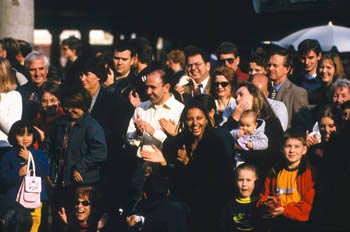
A crowd of identifiable people, any one of whom could object if the image was used for advertising or anything suggesting this was anything other than a small crowd watching a street entertainer. Collections/Ray Farrar
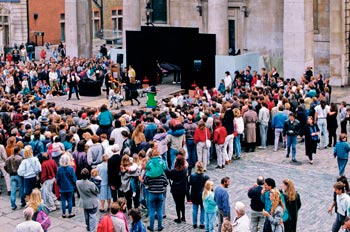
No one in this crowd, also watching a street entertainment, could easily be identified. Collections/Geoff Howard
These rights remain with the photographer regardless of what happens to his copyright, are designed to protect his artistic integrity, apply even if a photographer is employed and cannot be assigned. They give the photographer the right to be identified as the author, the right not to have anything falsely attributed to him and the right to object to derogatory treatment of a photograph - the same as Integrity Right. What constitutes derogatory treatment does tend to depend upon the photographer because in many cases, a photographer would rather take the money and close his eyes to what has happened.
A few years ago, photographer Fay Godwin had a retrospective exhibition. One of the venues was Edinburgh and because she was an important figure in the photography business, a national newspaper ran a lengthy and very enthusiastic review of the exhibition. They chose to use as an example of her work, an image of Meall Mor, a mountain in Glencoe. This is a very well known photograph - it was on the cover of her book Our Forbidden Land. It had a snow covered mountain in the distance with a road leading straight to it covered with white lines and arrows and the usual paint which local councils scrawl everywhere. The page designer decided it was a bit bland and used Photoshop to add voluminous clouds around the mountain. Fay Godwin was not only distressed - she was ballistic. To have done this to an iconic image, particularly when the image was being used to review an exhibition of her work was outrageous. The picture editor of the newspaper was appalled, sent a grovelling apology to Fay Godwin, printed a rather small apology in the paper - and sacked the designer.
What happened to Fay Godwin is akin to raising a Union Jack at Iwo Jima, body-piercing Einstein sticking out his tongue or supplying Che Guevara with a short-back-and-sides and a baseball cap. Barrister Christina Michalos, author of a genuine bible, The Law of Photography and Digital Images, likens it to dangling earrings from the Venus de Milo.
The derogatory treatment aspect of moral rights can include anything - inflating or deflating the proportions of a model, shifting a Pyramid to fit into an available space, altering an image to suit the whims of a designer, cropping anything by Cartier-Bresson, Ansel Adams or the like or colouring a black and white image. Printing a colour image in black and white has always been done although it can be annoying and is occasionally absolutely unacceptable.
Oddly, manipulating and cropping images doesn’t apply to reporting current events although the photograph has to have been taken for that purpose and should not be a stock picture. Neither does it apply to newspapers, magazines, encyclopaedias, dictionaries or collective works of reference, which would seem to cover a lot of ground. However, the copyright owner has to give his consent by waiver, usually in advance of the commission.
Also built into Moral Rights is the right of privacy in photographs commissioned for private or domestic purposes. This is a right which applies to the commissioner rather then the photographer. Although the photographer retains copyright, the commissioner can refuse to allow a photograph to be used. In simple terms this means that a photographer must ask the commissioner for permission before displaying private portraits in his shop window, putting them on his website or using them to promote his talents. It also means that if a photographer covers a wedding and during the honeymoon, the groom slaughters the bride, the photographer may not supply newspapers with pictures of the wedding without asking the commissioner – which might not be easy if the commissioner was the groom. Neither can the commissioner supply them because copyright belongs to the photographer. In that case, the less scrupulous newspapers will probably target wedding guests for ‘snaps’ but the commissioned pictures may only be supplied with consent from both sides.
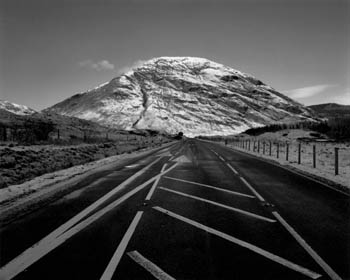
Meall Moir, Glencoe, Scotland. Fay Godwin’s original picture.
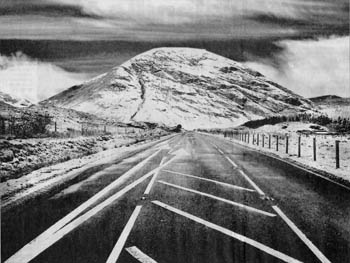
As it appeared in the newspaper.
In April 2010 the Digital Economy Bill was hauled in and approved in a hurry, amidst the chaos in the House of Commons as partially debated Bills were hustled through before the election in May. Tagged on at the end rather as an afterthought was Clause 43 which covered Orphan Works, how they would be managed by Copyright Licensing Agencies and how these agencies would be controlled. Where photographers were concerned, all of this was seriously bad news. However, very determined lobbying on the part of several associations who miraculously worked as one and knew who to lobby, succeeded in removing the dreaded Clause 43 altogether. It was agreed by all that insufficient time had been given to debate, that too many people would be adversely affected and that although there were some good points, they were outweighed by bad points. Orphan Works were sent back to bed but will all too soon get up again by which time there will be a load of new MPs to educate. Continue to watch this space!
‘Orphan works’ is a term used to describe a photograph for which the copyright holder cannot be identified or located by a potential picture user who has made a ‘reasonable and diligent’ search. Some years ago, legislation was proposed in the US to make all this material freely available and to limit the rights of any copyright holder who was subsequently discovered. This was fiercely opposed everywhere else and universally by photographers on the grounds that it gave carte blanche to copyright infringement. In October 2006, Congress threw it out but it’s not dead yet and despite the anxiety expressed by other countries and by American photographic associations, the US appear determined to wave it through regardless. The US Copyright Office insist that all photographic material should be registered but decline to establish a suitable register themselves and have stipulated this must be created by the private sector as a profit making commercial enterprise. No such enterprise yet exists. When it does, which could be years, photographers will be obliged to scan everything retrospectively in order to register with the Copyright Register in the US as well as with any number of new databases which will erupt as soon as entrepreneurs see a way of making a fast buck. Photographers from other countries already have copyright acts to protect their work. Everything about this legislation flies in the face of the Berne Convention.
The real trouble with the notion of free use of material which can’t be identified is that these days a lot of photographs appear, particularly on the Internet, without a credit. Additionally, although a potential user is supposed to make a ‘reasonable and diligent’ search, what is a diligent search? Having failed to find a name, the user can do anything with the picture - for nothing and it appears that it is the picture user who determines the extent of this ‘reasonable and diligent’ search! If the copyright holder appears, the most he can get is ‘reasonable compensation’ which means a reproduction fee which could also be determined by the picture user. No damages, nothing extra if the use of the image was not to the copyright holder’s taste, nothing if the picture user withdraws it immediately and absolutely nothing but hassle if the user refuses to pay. The reproduction fee won’t be big enough to make it worth while to sue, no lawyer would be bothered and the copyright holder could be left with huge, unrecoverable legal fees. Photographers in the US are used to registration. Not so photographers in Europe who already have rights as well as the Berne Convention which specifically states ‘the enjoyment and the exercise of these rights shall not be subject to any formality’.
see Metadata
A common law right which protects against those who attempt to represent their goods and services as the goods and services of someone else. The law of passing off has been summarised as ‘no man may pass off his goods as those of another’. Photographically, this could open up a massive can of worms although realistically, it would be a bit complicated but it’s always nice to know that if some villain starts selling rubbish images in the name of someone else, that’s false attribution of authorship and he can be taken to court and dealt with severely.
This is the right of a personality not to have his image used to advertise anything without his permission. Doing so may prove seriously expensive. Personalities don’t have to be famous although they usually are.
Anyone can post amost anything photographic on these sites and equally, anyone can access what is there. The sites are curiously uninformative about copyright and seem to consider it of no importance. The whole idea is that everything is shared so that people with specific interests can share their pictures with others who may be the other side if the world which is wonderful if all you want to do is show off your new house/baby/girl friend/dog. The danger is that those sharing the pictures could be mighty publishing companies who look upon the sites as a great source of free images. This is hardly surprising because it comes from all over the world and some of what is there is very competent material indeed although most of it is rubbish - all the things you might prefer to forget.
It is essential to read the Terms and Conditions on any site. There may be clauses which allow the company to exploit work without asking or paying. Flickr have an arrangement with Getty, it is optional, but if you agree you will have to agree to a Getty contributors contract. Some sites have clauses allowing them to exploit posted pictures for their own promotional advertising only, but some may have more dubious clauses - so beware.
Also known as Photo Library, Photographic Agency, Stock Library, Picture Archive, Image Library.
In theory, a ‘Picture Library’ is the collection of a single photographer who prefers to market independently what could be very specialised material. It may also be the accumulated collection of a museum or institute. A ‘Picture Agency’ markets material on behalf of photographers who do not wish to market independently and will take a percentage of sales. The two terms are frequently misapplied, have become interchangeable and the result is confusion.
Picture Libraries rarely purchase images outright. Picture Agencies occasionally do. Picture Libraries are reluctant to absorb material by other photographers because by so doing, they would become Picture Agencies with all the attendant impedimenta. Picture Libraries have less responsibilities than Picture Agencies. As a rule, Picture Agencies operate on behalf of contributing photographers who are often under contract, retain copyright in all their work and have the right to request the return of everything on completion of their contract. Picture Agencies are not necessarily particularly large - indeed some are quite small - but others are vast, with offices worldwide. Picture Libraries are usually small, often operate from a private house thus avoiding considerable overheads and are frequently in a position to supply extended information about their specialised subject. Picture Agencies supply material from all over the world covering news, celebrities, travel, lifestyle, history, art, cinema, sport and much more, most of it relatively generic. Some are in a category of their own, will purchase complete collections from photographers and cover photography from the nineteenth century to today. There are also Picture Agencies which specialise and are in a position to supply astonishingly detailed information about their particular specialisation.
I have to confess to getting cold feet over this one. Plagiarism happens because an image which appeals is used to create an alternative version. Sometimes it’s the plagiarist who is famous, sometimes it’s the original artist. Whichever, clearing rights on either version makes me nervous and for that reason, I have provided a few alternative options which include well known images discussed below on the assumption that somebody else has already cleared rights!
One image which I would love to have used is the brilliant pairing of the voluptuous painting Benefits Supervisor Sleeping by Lucian Freud which appeared in The Times on April 12 2008 on page 13 whilst on page 17 was one of the best ever cartoons by Peter Brookes. The Benefits Supervisor was a fleshy, naked Gordon Brown. This was plagiarism at its absolute best. I could have scanned them from the paper but that would have infringed too many copyrights. I could have asked The Times but they would probably have ignored me. As it is, I can look at my copies and hope that someone somewhere will consider it worth while making both images available!
Taking the thoughts and ideas of someone else and using them as one’s own is plagiarism. This doesn’t mean using a photograph taken by another person as if it was your own. It means using the photograph to create something new which is based upon the same idea. Occasionally an idea will be used which is not attempting to plagiarise but is in a subtle manner paying homage to the original. That is parody. There are many versions of the image of Christine Keeler straddling a chair, a carefully protected image taken by by Lewis Morley in 1963. He parodied his own photograph by putting Joe Orton, David Frost and Dame Edna Everage in the same position but it has been parodied by other artists, some of whom may intend a form of homage although Lewis Morley may not be particularly gratified. Possibly it depends upon who is straddling the chair - he has admitted to being taken with the Homer Simpson version. Cartoonists seem to be at an advantage and get away with parodies which would not be acceptable photographically. Another popular and much parodied image is ‘Tennis Girl’ by Martin Elliot, the most famous Athena poster of the seventies, recently resurrected and still parodied. Yet another is The Beatles crossing Abbey Road whichfrequently appears with different groups, most recently with a red carpet instead of a zebra crossing.
It is often worth while looking up a word in a dictionary. According to the Concise Oxford Dictionary, ‘plagiarise’ is ‘take and use another person’s thoughts. writings,inventions as one’s own ’; ‘parody’ is ‘composition in which an author’s characteristics are humorously imitated’, ‘caricature’ is ‘grotesque usually comically exaggerated representation’ and pastiche is ‘composition imitating or made from various sources’. Pastiche is not often accomplished photographically. It is not always easy to define the point at which parody becomes plagiarism. Whatever, parody is still an infringement if done without permission unless it could be seen to come under the heading of ‘criticism and review’.
Some relevant links...
An interesting article from the V&A web site on the Christine Keeler picture.
A large selection of variations on Abbey Road from the Daily Mail web site.
There does not seem to be a single site that collects together the Tennis Girl plagarisms, but Google Images have dozens. (Warning, the results may not be decent!)
Sticking to photography, this is a photographic print made from a black and white negative, colour negative, colour transparency or digitally. On the whole, publishers dislike printing from a colour print because the quality is never as good as a colour transparency. Black and white is different and the prints can be beautiful but nowadays, black and white prints are scanned and sent digitally if a negative is not available for scanning. A print is second generation. A negative and a transparency are first generation - that is, they are the same bit of film which was in the camera. Digital prints can be made from analogue transparencies and negatives which first need to be scanned. Digital prints get better and better as the technology improves and has more-or-less done away with the need for a dark room.
The UK does not have strict privacy laws whatever exasperated celebrities and people in the street may claim. Several well placed celebrities have taken tabloid newspapers and popular magazines through the High Court in order to protect their private lives from photographers determined to supply material of celebrities doing whatever it is celebrities do and rules have crept in through the back door but on the whole, there is nothing to stop photographers taking pictures in public places although publishing them might pose a problem.
The UK abides by the Human Rights Act, which says: ‘Everyone has the right to freedom of expression. This right shall include freedom to hold opinions and to receive and impart information and ideas without interference by public authority and regardless of frontiers’. It also guarantees ‘the right to respect for private and family life, home and correspondence’. Intrusive photographs may be published if they are considered to be ‘in the public interest’ but what that means is open to question. There are publications which would interpret this as what interests the public rather than what is in the public interest.
When it comes to photographing people whether they are celebrities or not, harassment is illegal. There are celebrities who are harassed every day and there doesn’t seem to be a great deal they can do to prevent it. There are folk around who reckon that a celebrity photographed in a public place and subsequently published is no different from anyone else and that everyone should have the right to object to photographers intruding into what they might like to consider their private lives and their private space, even if the private life is simply shopping in Oxford Street. Reason says they have a point but photographically, Oxford Street would look forlorn devoid of shoppers.
Despite the efforts of the Press Complaints Commission (PCC) who are supposed to monitor and police publication, there are newspapers and magazines who will publish and be damned because the benefit of additional sales will make it worth while if the subjects are celebrities. There are celebrities who actively encourage papparazzi because they need the rush of adrenalin which comes with the encounter and are fearful of becoming has-beens. Where there are nubile celebrities who party and shop, there will be prowling photographers who will either be welcomed with professional enthusiasm or scowled at. It begs the question whether anyone is interested in a celebrity pushing an Asda shopping trolley filled with cornflakes, baked beans, bottles of Rioja and a baby but the pictures appear with tedious regularity. These days, it is not necessary to be a celebrity to be photographed individually in the street. Obesity and anorexia are all around us and much discussed. It must be deeply mortifying to identify yourself on the front page of a newspaper, bulging or otherwise, pinpointed as an example of the failure of modern nutrition. Many view this as an invasion of privacy - and it is.
Anyone can take photographs in the street, but these days, it’s as well to think twice about publishing them. An image of a woman in the street, taken in 1977 and published today can have a sting in the tail It doesn’t matter when the picture was taken - it matters when it gets published and it matters what the caption suggests. If a stock photograph of a group of people has a caption which claims that 50% are drug pushers, wife beaters, paedophiles or undercover policemen, someone will sue - and so they should. The publication will blame the photographer who will have to prove conclusively that the material was supplied as having no model release. If the original image was fifty people in a park, model releases are not an option. Theoretically it’s fine to photograph a crowd but what constitutes a crowd? It could be twenty people in a lift or 50,000 at a football match.
Privacy Rights have slipped through the net because nowhere does it say how long they last. In the absence of written legislation, it appears that it all becomes a free for all once a celebrity - or anyone else for that matter - has gone to meet his maker.
Solicitor Rupert Grey has written a good paper about privacy, The Long Lens of the Law. He read this at a British Association of Picture Libraries and Agencies (BAPLA) AGM and if you haven’t seen it, you should because it’s easy to read and very revealing. With his permission, I reproduce his summary:
There is no law in the UK that says you cannot take photographs of people in a public place.
If the subject of the photograph has a reasonable expectation of privacy at the time it was taken, the publisher will be at risk of a claim. So will the agency who supplied it and the photographer who took it.
If the subject does not have such an expectation, there are two possible responses:
- publication of the picture is in the overriding public interest; and/or
- the image, or the moment captured, is already in the public domain.
The familiar kiss-and-tell fodder is under threat. They constitute an invasion of privacy, almost by definition. It is difficult to imagine how pictures of such limited value can qualify for the public interest defence. Each case will be fact sensitive and will depend on the circumstances in which it was taken, the detail of the photograph and the track record of the subject. So I have five bits of practical advice. None of them are particularly palatable.
- All pictures from now on which suggest that the subject did not expect to be photographed should have a note attached describing the circumstances in which it was taken.
- Get the subject’s consent. Written is best but verbal plus a contemporary note should see off most complaints.
- Pictures of an individual in the news may be fair game at the time but not necessarily months or years later.
- Know your market-place; some celebrities are particularly possessive of their privacy - especially when it involves their children.
- Put some money aside to pay your lawyers.
These don’t matter as much in Britain as in some other countries but it’s only a matter of time. If a building is visible from a public right of way, there are no restrictions on photographing it or publishing it editorially. If there is a company logo on it, there could be problems with the logo but only if the reference is defamatory. If the owner of a house appears and asks you to move on, do so. If you already have the pictures and choose to use them, that is your business and not his. If you trespassed to get the pictures, he can have you for trespass if he can prove it. If the photograph is used in advertising, a property release is essential - just like a model release. Consider the implications if a stock picture of a pretty thatched cottage was used in an advertising campaign for Coca-Cola and and the owner of the cottage turned out to be a director of Pepsi!
see Restrictions
A total absence of copyright protection which theoretically means that anyone can use a picture for anything they wish and the author, if he is still around has no exclusive rights. However, if the physical image is owned by someone else, a fee may be due for getting hold of it in the first place. Photographs arrive in the public domain either because the term of protection has expired or because the author has released the image without the intention of claiming copyright or any benefits. Clients sometimes distribute photographs to all and sundry, originally as prints but now digitally and these escape. There isn’t a lot the photographer can do about it and he is unlikely to want to do battle with a client.
Sadly, photographs can be dumped in the public domain by accident. A generous photographer, supplying prints to his sitters may find that the same prints are appearing in books, on websites and on CD covers because the sitter or his family didn’t realise this was not permitted and the publishers either failed to read the printed warnings on the back of the print or scanned the print and ignored them. A typical example is an image of composer Olivier Messiaen, swathed in a multi-coloured, knitted scarf. It was Messiaen’s favourite picture but after he died, it appeared everywhere and photographer Malcolm Crowthers couldn’t keep up with the infringements. Many were made available by the widow of Messiaen who simply failed to understand. Google ‘Olivier Messiaen’ and ‘Images’ returns countless examples of this picture, hardly any of which are legitimate. It has simply escaped into the public domain. Some years ago a photographer sent prints to a group of traditional dancers. A couple of years later, he returned to the event and found linen tea-towels on sale covered with terrible drawings made from his prints. The illustrator had even signed them. They were £1 each and were selling to raise funds for the dancers so he bought three and did nothing.
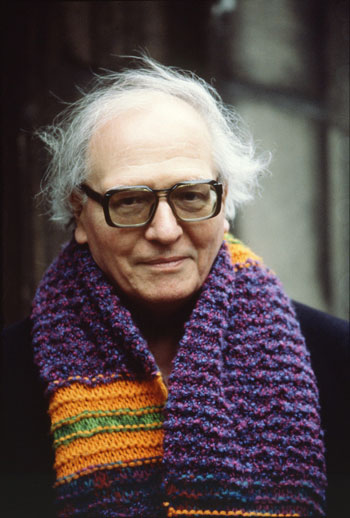
Olivier Messiaen. Malcolm Crowthers

Brian Shuel
Publication right applies only from 1 December 1996 but affects everything which is out of copyright and unpublished, however old. The owner of publication right is whoever publishes for the first time a previously unpublished photograph in which rights may have expired many years ago, although this can only be done with the consent of the owner of the physical photograph. This includes everything from the earliest nineteenth century photographs onwards. This particular right expires at the end of twenty five years from the end of the year in which the work is first published. Archives of old photographs are vulnerable. Those who hold such collections should make sure they understand this bit of legislation before agreeing to anything because they may get nothing in return. Better to scan and produce postcards first because this will ensure copyright stays with the physical photograph and postcards - however cheap - ensure a photograph is published and sales may provide a small income.
A photograph is published if it appears in a book, catalogue, magazine, on TV, a website, a t-shirt, a poster, coasters, jigsaws, anything like that. It is not published if it appears in an exhibition as a photographic print but it is if it appears in the exhibition catalogue. A photographer who prints and stores lots of his pictures in order to supply clients has not published them but the instant he prints one as a publicity card, it’s published. If a print is sold to a collector who intends to hang it on the wall and enjoy it, it is not published.
Photographs of sculpture and statues on permanent display in public places do not infringe copyright. Anyone can photograph Antony Gormley’s Angel of the North, the Henry Moore’s scattered about London, the Maggie Hambling on the beach at Aldeburgh or the Elisabeth Frink at the junction of Piccadilly and Dover Street, which seems to be a permanent picnic table for tourists - but don’t use them in advertising without the permission of the copyright holder. Sculptures on private premises are a different matter but if a sculpture is in a front garden and visible from the street, it becomes incidental - don’t trespass though and make sure the photograph clearly is ‘incidental’. Homing in with a long lens across the garden wall may not be proper. Murals painted on public walls can pose problems and it may be necessary to obtain clearance. Always credit the artist whether it’s a mural or a sculpture, not so much because it’s a legal obligation but because it’s useful information which many people will want to know.
If a photographer attempts to take pictures in Trafalgar Square, he is likely to be prevented but if he has a small, digital camera and is accompanied by a wife and a toddler in a push chair, he is unlikely to be stopped, although in some places, even that isn’t permitted. If, despite the restrictions, the pictures are taken and the photographer escapes unscathed, the copyright is his and he can do what he wants with them because in Trafalgar Square, there don’t appear to be any signs stating photography is not allowed - only pigeon feeding. What is restricted in the Square is commercial photography. In order to take good stock pictures, a superior camera and a tripod are vital and the tripod is the problem. They are banned practically everywhere because they pose a hazard. If someone trips over one, there is public liability to consider, not to mention Health and Safety. This may be a nanny state, but tripods are a pest in public places and if you are moved on it may be because you are causing an obstruction rather than for taking photographs, even if it is not made clear at the time.
The National Trust and similar associations pose difficulties. The NT is a company which holds property in trust for the nation. The nation is all of us. They have the right to prevent photography inside their properties because it’s intrusive and annoying for other visitors and requires a tripod which may have a footprint bigger than a seriously obese human being, but their policies are less acceptable regarding photography outside properties, particularly from public rights of way or in places where there is no charge to enter and no signs restricting photography. There have been photographers who have had questioned their right to publish pictures taken from a beach where there is unrestricted public access. The foreshore between the high and the low watermark which would seem to belong to everyone doesn’t necessarily provide the public with a right of way and access may be conditional on the tolerance of the land owner. There is an assumption that all the bit between high and low tide belongs to the Crown but there may be other owners. Photographers should have a go anyway because it’s worth it. Once again, anyone on a National Trust property with family seems to be immune. Maybe the answer is to invest in the very best small camera available and borrow a toddler, a mother and a push chair if they are not readily available. If pictures are taken from an area for which there is an admission charge and are published, this is breach of contract but the NT will have to prove that there were signs which were clearly visible. NT members will have a membership card which makes their policies absolutely clear. If you want to take photographs on NT properties for which there as no admission charge, do not join the National Trust. Many places are free and without a ticket, there is no reason why you should know there are restrictions. Whatever anyone may insist, copyright in the pictures remains with the photographer.
Some government buildings are restricted and being seen taking pictures outside could result in a posse arriving with sirens, body armour and handcuffs because such images may be of use to ‘an enemy’. Restricted areas include post offices, police stations, power stations and practically anywhere that is infested with officials in uniforms. Photography in a court of law has long been forbidden and that includes the precincts which is probably why so many court reports on television are conducted in the rain in the street outside. Shopping Malls crawl with officials preventing photography. Railway stations and airports are restricted. Paternoster Square, Canary Wharf and open spaces in front of many office blocks are private property. Take commercial pictures from the other side of the river but not on site. The Eiffel Tower is a disaster area - not the tower itself which is long out of copyright but the lighting, for which the designers claim copyright. The Pyramid outside the Louvre is a no-go area. It’s fine to take a photograph of a bit of it but not all of it, France has much stricter rules than the UK regarding photographing buildings. Ayers Rock is sacred and a permit is required plus a meeting with a ranger and even then, it is forbidden to photograph the top at dawn. Market stalls in many places are difficult because the traders are aggressive and don’t like it and the London Transport logo is banned - unless it’s incidental and it would seem they have the right to determine what is incidental. The logos scattered indiscriminately all over sports personalities shirts, sweaters and headgear are protected. You may take a photograph but don’t try to publish it. Do not photograph a policeman in the execution of his duty. And so on and so on and so on. Who would be a photographer?
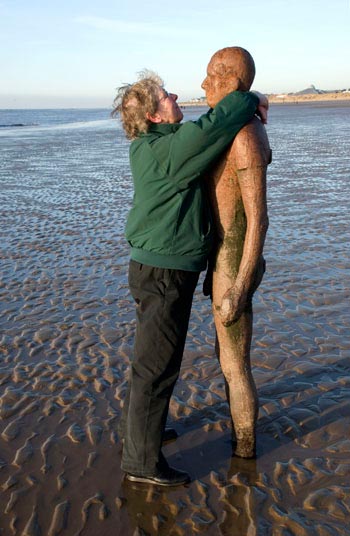
Sal and Antony Gormley. Another Place. Brian Shuel

Aerial photograph of Sizewell Nuclear Power Station. Not only is photography restricted, you aren’t allowed to fly over them either. Collections/David Bowie
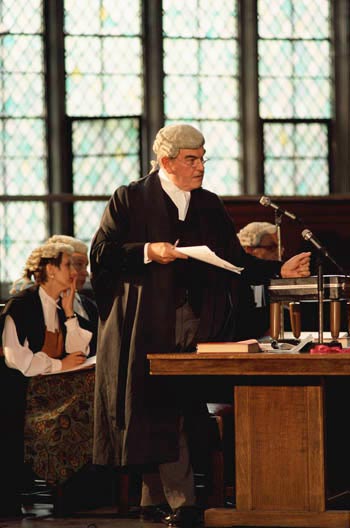
Photography in a court of law is banned. Collections/Brian and Cherry Alexander
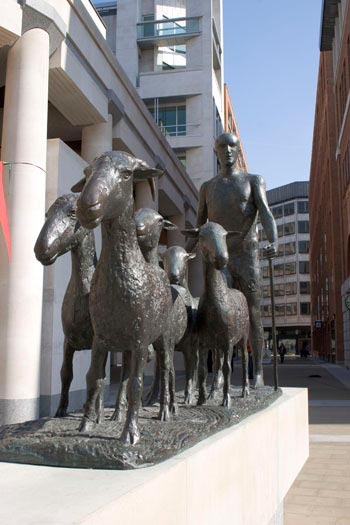
The Good Shepherd by Elizabeth Frink. This may look like a sculpture in a public place, but this is Paternoster Square which is private. If this was a public place photography would not be a problem. If you get your picture anyway, copyright is yours and you can publish it. Collections/Michael Jenner
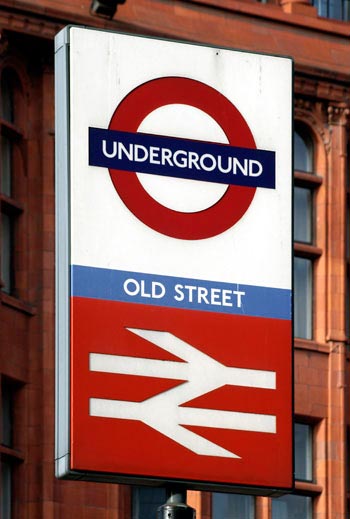
London Transport do not allow their logo to be published unless it is incidental, this is not. Collections/Dominic Cole

However, this is incidental. Collections/John Bethell
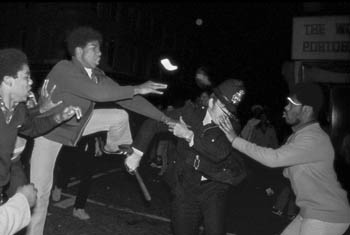
Taking photographs like this is dangerous. Five minutes later the photographer was arrested. Why is uncertain. David Hoffman
This is what happened after 1 January 1996. Copyright was effectively revived in a huge number of photographs which were already in the public domain. Provided the photographer had not died more than seventy years before that date, he or his heirs acquired copyright protection for the balance of the term of seventy years pma remaining on 31 December 1995. Alternatively, the person who was the owner of the copyright at the point when it expired, who may not necessarily have been the photographer, reacquired it for the same term. If someone other than the photographer owned the copyright when it expired and they died before January 1 1996 or if copyright was owned by a company which had ceased trading, the copyright reverted to the photographer and if he too was dead, to his heirs for whatever was left of the seventy years pma.
If there was nobody left after all that, the photograph went into the public domain.
see Extended Copyright
Rights Managed are images which are licensed for a specific use only which should be negotiated in advance. Any additional use requires a further payment. There is no question of an assignment of copyright although for an increased fee, exclusive use may be negotiated which may either cover all usage or be confined to some specific form of publication only and for a specific amount of time. All images used, particularly when analogue but also when digital, should be returned to the copyright holder or his agent or deleted once used. Failure to return original, analogue transparencies may result in a holding fee for hanging on to them for too long and losing them will result in a loss fee
Royalty Free is a stock photography licence which means a client will pay a one-time fee and use the photograph for practically anything and in perpetuity within the constraints of the licence without further payment but cannot licence the photograph to anyone else without the permission of the licensor. This could mean the image being used as a poster or in an advertising campaign, on the cover of a best selling book or on a popular website - none of this with any time limit provided the licence allows it. Photographs of people should not be made available without a model release because this could cause problems. Royalty Free does not mean copyright free. If the copyright isn’t owned by the company, it’s still owned by the photographer.
A collection of photographs which are available for use by publishers or advertisers unwilling to commission or unable to get what they need by commissioning. Stock photography may be general but it can also be specific; travel, history, food, wild life, celebrities, architecture - anything. Specialist libraries are often able to supply considerable information about their particular subject. Wild life libraries will have a great depth of knowledge about fauna and garden specialists about flora. It’s not just about pretty pictures. A real cinema specialist will have available an enormous amount of information on film, actors, directors and everything to do with cinema including posters and equipment. A mountain specialist can be guaranteed to supply pictures of Mont Blanc and not the Matterhorn when a request is for Mont Blanc. A picture researcher will go to a stock library for the items which are otherwise impossible or expensive to get like the 1953 Coronation, a moon walk, obscure country mansions, Cleethorpes, building the Statue of Liberty, a field of poppies needed in December or the Taj Mahal in twenty minutes. An advertising agency will use stock rather than pay for model, stylist, art director, make-up, photographer, assistants and assorted wives and girl friends when all that is wanted is a pretty girl on a beach in Bermuda.
see Picture Library, Picture Agency
Not so much the people in the street but the street itself which usually includes people. The French created street photography and the French were the first to destroy it. In the States, paranoia has taken over because of fear of litigation. Whether we like it or not, we are going to have to get used to photographs which include no real people - only models. However, there are aspects of street photography which are less of a problem. Buildings require property releases in the States but not here - at least, not yet. It is not a copyright infringement to take photographs of any work of art, building or part of a building if it is in a public place or is in a building which is open to the public. A ‘Building’ is any fixed structure or part of it. Neither is it a copyright infringement to publish such pictures. Details of old buildings, if they are clearly visible from a public right of way are not restricted. Whatever the owner of the property may claim, a photograph of a Georgian front door complete with original knocker, door frame, boot scraper, copy of The Sun stuck in the letterbox and milk bottle on the step is not restricted. If the irate owner is peering out of the door, that’s different. Do not be browbeaten into deleting the image from the files just because the owner claims the picture is an invasion of his privacy or that he owns copyright in everything to do with the property. If he is not in the picture and there is no suggestion that he owns the property, it’s fine. The same applies to window detail, roofs and tiles, chimneys, timber-framing, and anything else which is permanently attached to a property. The owner of a property does not own the copyright in anything attached to the house. However, if approached by an irate owner clutching a shotgun, make a hasty retreat.
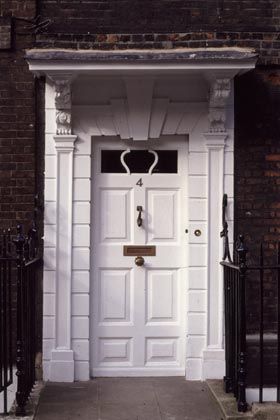
The front door of a publisher who protested to the photographer that he owned the copyright to his own property. He doesn’t. Edifice
Photographers supplying unsolicited material still retain full rights in the photographs and can claim a fee if the photographs are used. What they lose is any right to complain if analogue material disappears or is damaged. Whilst all picture users appreciate the requirement to take care of everything supplied, they cannot be held responsible for guaranteeing everything will be returned - even if return postage is supplied. Unsolicited analogue submissions often vanish in the office mess as do unsolicited submissions on CD which may end up as bird scarers in the garden. Photographers are inclined to supply CDs with no covering letter and no identification - other than an e-mail address scrawled on the disk. This is seriously unprofessional. Nowadays, images are more likely to be supplied by e-mail. If they are unsolicited and high resolution, photographers have only themselves to blame if the images go walkabout.
Television companies are forever asking viewers to send in their pictures when there are extremes of temperature, if there is a disaster or some spectacular event. If these pictures are something special, do this with caution because if it’s very special and newsworthy, it could end up appearing everywhere without putting a respectable fee in the photographers pocket. Bear in mind that in most circumstances, these will be pictures for which the company would normally be obliged to pay a fee. Anything taken using a mobile phone is protected by copyright. Photographs taken during disasters - those terrifying pictures of commuters trailing through underground tunnels, distraught victims of accidents, flash floods - the sort of pictures which can only be taken by somebody who was there and happened to have a mobile phone - should be fed through a legitimate picture agency and might produce a sufficient return to cover the cost of a better camera. Images of disasters which include people are subject within the EU to the human rights of the victims in the photographs so they may not be exploitable – a fact which does not seem to have concerned those who publish the pictures in a hurry, presumably on the grounds that the possible fines will be well covered by the increased revenue from sales of the publications.
Never assume that the person to whom you have bequeathed your house, your silver, your diamonds and the contents of your savings account will take kindly to inheriting your photographs and your copyright. Make sure before you commit anything to writing that whoever inherits your material knows what to do with it and is willing to take on the responsibility of handling it. Copyright is a property right - it’s just like owning anything else and can be bequeathed to whoever you like. You can leave your house to one person, your silver to another, your jewelery to a third and your money to a cats’ home but leave your copyright to someone who understands and wants it - and bequeath them a copy of this document too.
Back to the front page


























